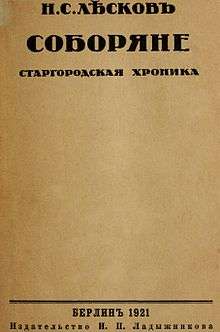The Cathedral Clergy
The Cathedral Clergy (Russian: Соборяне, romanized: Soborya′ne), also translated as Cathedral Folk, is a novel by Nikolai Leskov, a series of "romantic chronicles" (as the author called them) of the imaginary town of Stargorod. It was first published in Nos.4-7, 1872 issues of The Russian Messenger magazine[1] and formed a trilogy with Old Years in Plodomasovo (1869) and A Decayed Family (1874).[2]
 1921 title page | |
| Author | Nikolai Leskov |
|---|---|
| Original title | Соборяне |
| Country | Imperial Russia |
| Language | Russian |
| Genre | Romantic chronicles |
| Publisher | The Russian Messenger |
Publication date | 1872 |
| Media type | Print (Paperback & Hardback) |
Background
Leskov started working on his "romantic chronicles" in January 1866.[1] In 1867, Book 1 appeared in issues 6–8 (March–April) of Otechestvennye Zapiski under the original title of Waiting for the Moving of the Water. The Romantic Chronicles (Чающие движения воды. Романтическая хроника).[1][note 1] The publication was stopped after a row between Leskov and Andrey Krayevsky over the cuts that had been made. Then Literaturnaya Biblioteka started publishing the novel from the beginning, in its first two issues of 1868 (as Dwellers in God's House. Chapters from the Unfinished Novel), but then stopped. Only in 1872 did The Russian Messenger publish the full text of a revised version of the novel as The Cathedral Clergy.[1]
In its original version (the one published in Otechestvennye Zapiski), the novel dealt more with the life of Stargorod in general, focusing on its starovery community, but also describing in detail the ordinary, non-religious people's spiritual leanings. Book I looked more like background for the story of Savely Tuberozov, the novel's main character. In the Russian Messenger version, most of the side plots, which had little to do with protopope Tuberozov and his colleagues, have been cut. Konstantin Pizonsky and Platonida, who featured prominently in the chronicles, disappeared from the latter version and resurfaced as the main characters of the short story "Kotin the He-Cow and Platonida," which was included into the collection Novelets and Short Stories by M. Stebnitsky (Vol.1, 1867).[3]
Synopsis
Priest Savely Tuberozov is a spiritual leader of a small Russian Orthodox community (sobor) in a provincial town of Stargorod. He firmly believes in his spiritual and social mission, and, unwilling to make compromises, comes into conflict with his church seniors, as well as the local authorities. The latter expect him to "eradicate raskol" (schism), and report on dissenters. He refuses to comply and condemns the destruction of the Old Believers' church as barbarism. As the Governor comes to town, Tuberozov makes the speech, accusing the local masters of exploiting peasants and abusing the local rural areas. The Governor doesn't want to listen, and protopope Tuberozov, reprimanded for such an audacity, gets demoted in ranks. He summons the local officials to a moleben and preaches a sermon which sounds more like a political speech, promising dire things to leaders who treat their people as animals. Tuberozov gets fired, goes through numerous humiliations, falls ill and dies.[4]
English translations
- The Cathedral Folk, translated by Isabel F. Hapgood, John Lane, 1924.
- The Cathedral Clergy: A Chronicle, translated by Margaret Winchell, Slavica Publishers, 2010. ISBN 0-89357-373-6
Notes
- From the Gospel of John: "In these lay a multitude of them that were sick, blind, halt, withered, waiting for the moving of the water. (V, 4) For an angel of the Lord went down at certain seasons into the pool, and troubled the water: whosoever then first after the troubling of the waters stepped in was made whole, with whatsoever disease he was holden. (V, 5)
References
- Bogayevskaya, K.P. "The Life and Works by N.S. Leskov. Timeline". az.lib.ru / The Works by N.S. Leskov in 11 volumes. Moscow, Khudozhestvennaya Literatura Publishers. 1958. Vol 11, pp. 799-834. Retrieved 2011-10-10.
- D.S.Mirsky, Francis James Whitfield. Leskov. A history of Russian literature from its beginnings to 1900. Retrieved 2011-10-10.
- Bukhstab, B. Commentaries. The Works by N.S. Leskov in 6 volumes. Pravda Publishers. Moscow. 1973. Vol.2. P. 388.
- Bukhstab, pp. 14—15
External links
- Соборяне. The original Russian text.